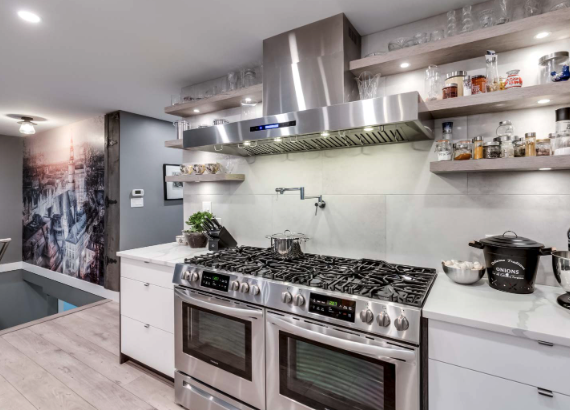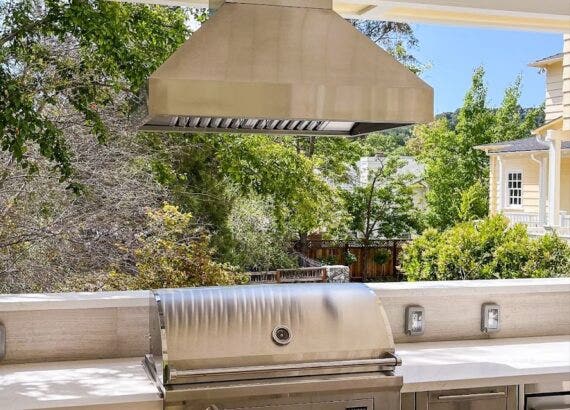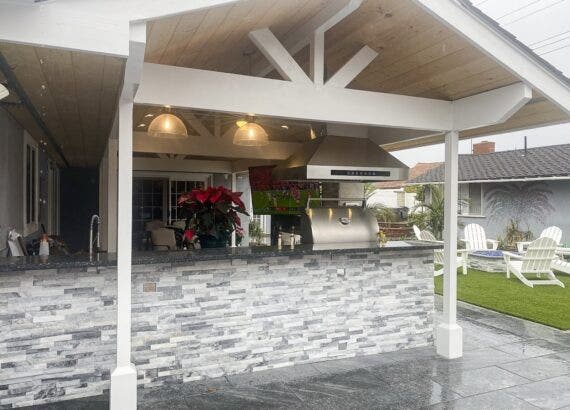The Ultimate Guide to Working With Clients and Range Hoods

In this article, we’ll go over several ways that you can ensure your customer is pleased with your range hood installation. These tips all involve being transparent with your client. It is important to prevent all miscommunication, so being transparent is crucial to keeping a happy customer.
Beyond transparency, the main thing you’ll want to focus on is getting the right hood to your client and then installing it properly.
Also, be sure to give them some advice on cleaning and maintaining their hood. This shows them that you are a reliable, trustworthy contractor. Not to mention that it keeps you from getting calls in the future about a range or vent hood that needs fixing.
We’ll discuss installing the hood first, and then move on to the cleaning and maintenance tips. We know that keeping your customer satisfied is one of your highest priorities. With these tips, we hope to expedite your installation process and ensure you prioritize your client’s needs.
Before Installing Your Client’s Range Hood
Before installing your client’s range hood, be sure to ask them the five questions below. We want to ensure they are happy with your work for years to come.
Some mistakes that are made when selecting and installing range hoods come with a decent price tag. So, it’s incredibly important to double and triple check with your client about their range hood requirements and preferences. Once you have clear answers to these questions, you can proceed with the installation.
You never want to tell a customer that their range hood was installed incorrectly and that it can’t be fixed without extra cost to them. That’s why we’ve provided you with these questions. They’ll save you time and you’ll avoid the hassle of dealing with an unsatisfied customer.
- Do they want their hood to duct to the outside? – Range hoods are either ducted or ductless and, on average, ducted hoods cost more and take more time to install.
- Is there space in their walls for ductwork? – Without adequate space, your client won’t be able to duct their hood to the outside.
- What type of blower do they want in their hood? – Your client has the choice of a local or inline blower.
- How high above the cooktop does your client want their hood? – Indoor range hoods should be mounted between 28” and 36” from the cooktop, while outdoor hoods should be mounted between 36” and 40” from the cooktop.
- What duct size does your client need? – Duct size depends on the cubic feet per minute (CFM) of your range hood; the larger the CFM, the larger the duct size needed to push the kitchen air outside the home.
Do they want their hood to duct to the outside?
Range hoods are either ducted or ductless. Ducted range hoods filter air through ductwork that runs horizontally or vertically to the outside of the home. Ducted range hoods are incredibly efficient and keep the air cleanest and freshest compared to ductless range hoods. So, if you want to ensure a happy customer, definitely suggest a ducted range hood whenever possible.
If you duct the hood to the outside, you have two options: horizontal or vertical venting. Wall range hoods, under cabinet range hoods, and inserts are often vented through the wall but they can also be vented through the ceiling.
Here’s a couple of vertical venting options, one for wall and one for island range hoods.
Horizontal Venting Options
Wall and island hoods can also vent horizontally; here are a couple of examples. Keep in mind that an island hood must first vent vertically, then you can add an elbow. If you choose one of these venting options, make sure that you have 18” of ductwork before any 90º turns. This will keep your client’s kitchen air flowing efficiently.
Ductless Range Hoods
The other option is a ductless range hood. Ductless range hoods filter air through charcoal filters inside the hood and recirculate it back into your client’s kitchen. These hoods are also called recirculating hoods.
One common complaint we receive at Proline is that ductless hoods do not vent air with enough power outside the kitchen. But, they will certainly clean the air better compared to no range hood. Also, if your client lives in an apartment or condo where you can’t install ductwork, a ductless range hood is their only option.
Convertible Range Hoods
Your client has a third option too: convertible range hoods. These are ducted range hoods that can be converted to recirculating or ductless, either by adding charcoal filters or a recirculating kit to the top of their range hood.
Note: Once your client converts their hood to ductless, they can’t switch back to a ducted hood. So, talk to them and make sure they are 100% confident in their decision.
Most often, we see customers decide on a convertible range hood because they like the style of a ducted hood but want it to recirculate.
Is there space in their walls for ductwork?
To install a ducted range hood, your client will need to make sure that they have enough room inside their ceilings or walls to vent ductwork to the outside. The main thing you’ll need to be aware of during installation is the location of studs and other wooden structural beams. You’ll need to navigate around these to run the ductwork to the outside.
Talk with your client and see if they have any building plans for their home, or go and do a visual inspection of their home. Then you’ll be able to give them a great recommendation for where to mount their range hood and run the ductwork.
What type of blower do they want in their hood?
Your client has two options for range hood blowers: a local blower or an inline blower. A local blower sits inside the range hood, while an inline blower is installed inside the ductwork.
Inline blowers are further away from the range hood, so they’ll be quieter than a local blower. They can be installed as far away as in the ductwork at the roof level.
How high above the cooktop does your client want their hood?
For a range or stovetop, range hoods must be a minimum of 28” away. Generally, indoor range hoods are installed between 28” and 36” above the cooktop. This prevents excess heat damage or melting of the circuitry, so it’s vital that your client’s hood is installed within this range. If the hood is mounted too far away from the cooktop, it won’t vent unwanted air out of the home as efficiently.
If you’re installing an outdoor hood above a grill, mount it between 36” and 40” from the cooktop. This compensates for the intense heat produced by grills for barbecues.
What duct size does your client need?
If your client is purchasing a ducted range hood, they’ll need the right ductwork to vent unwanted air to the outside of their home. The diameter of this ductwork makes a difference in how their new hood will perform and should be calculated based on the power or cubic feet per minute (CFM) of the range hood.
Here’s what is recommended for duct size based on the CFM of the range hood.
- 0-400 CFM: minimum 4”, 6” recommended
- 401-600 CFM: minimum 6”, 8” recommended
- 601-900 CFM: minimum 7”, 8” recommended
- 901-1200 CFM: minimum 8”, 10” recommended
- 1200+ CFM: minimum 10”, 12” recommended
After Installing Your Client’s Range Hood
After installing your client’s range hood, you can leave them with several helpful tips to ensure they have a great experience with their new hood.
Cleaning Range Hood Filters
Most range hoods come with either stainless steel baffle or mesh filters. To keep a range hood working efficiently, clean the baffle or mesh filters every three to six months.
If you do a lot of wok-style, Chinese, or Asian cooking, inspect the filters every month for grease and dirt and clean them as needed. Stainless steel filters are dishwasher-safe – you can also hand wash them with soap and water.
If you installed a ductless range hood for your client, they may be using charcoal filters. These are not cleaned, but rather replaced after about 120 hours of cooking (about three to six months), or if you begin to notice harsh smells in the kitchen.
Cleaning the Range Hood
Your client’s range hood will also need occasional cleaning. For a quick, easy clean, tell them to use a glass cleaner. For tougher dirt, they can apply acetone to a cloth and wipe the hood along the stainless steel grain.
For more information on cleaning range hoods, take a look at the video below.
How to Clean the Motor
The blower shouldn’t need cleaning as long as your client maintains their range hood filters. But if they notice that the hood isn’t pulling as much air as it should, their blower may need cleaning.
They can unscrew the blower from the range hood after removing the filters. Then, remove the plastic cover of the blower and they’ll have access to the fan blade. These can be scrubbed with soap and water or placed in the dishwasher. Take a look at the video below for more information.
Your customer may need make-up air for their range hood.
Make-up air replaces air in your client’s home that is vented to the outside. This attaches to their ductwork along with an air pressure sensor. It releases when air pressure drops below a certain level and closes when there’s enough air in the kitchen.
Unless they run their hood constantly or install a high CFM (1200+) hood in a small kitchen, your client won’t require a make-up air kit. Make-up air kits are never required with ductless range hoods since the air recirculates back into the home.
Check out a great makeup air kit on Amazon here.
Range Hood Dampers
Always recommend to your client to install a range hood damper for your client. A damper is installed inside their ductwork to prevent leaves, dirt, and other debris from falling inside. It also prevents back-drafting if you install it closer to the range hood unit. Backdrafting occurs when air travels from inside the ductwork, through filters, and into the kitchen.
Bonus Tip!
When range hoods are shipped, smaller hoods are shipped ground and larger, heavier hoods are shipped freight. Freight shipments are generally shipped to the garage or driveway, while most ground shipments show up at the front door. Check out the range hood distributor’s website for specific shipping times. Then you can work with your client to finalize a timeline for the renovation.
Recap
The most important thing for you to do is to communicate with your client. Make sure that they are 100% confident in their range hood. The last thing you want is to tell a customer that their hood can’t be converted to ductless, that the hood was mounted too low, that their duct size is too small…the list goes on. Just follow these tips to help you have a smooth range hood installation experience.
Once you’ve completed the installation, you can help your client out even more by telling them all about how to maintain their range hood and keep it in good condition. Your customer will surely appreciate it – and it’s a great way to gain their trust. That way, if anything does go wrong, you’ll be the first person they contact for help!
Hopefully, these pre and post range hood installation tips were helpful for you. Good luck with the installation!
As an Amazon Associate, we earn from qualifying purchases.







Comments are closed.